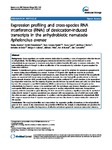Expression profiling and cross-species RNA interference (RNAi) of desiccation-induced transcripts in the anhydrobiotic nematode Aphelenchus avenae
| dc.contributor.author | Reardon, W | |
| dc.contributor.author | Chakrabortee, S | |
| dc.contributor.author | Pereira, TC | |
| dc.contributor.author | Tyson, T | |
| dc.contributor.author | Banton, Matthew | |
| dc.contributor.author | Dolan, KM | |
| dc.contributor.author | Culleton, BA | |
| dc.contributor.author | Wise, MJ | |
| dc.contributor.author | Burnell, AM | |
| dc.contributor.author | Tunnacliffe, A | |
| dc.date.accessioned | 2020-04-06T10:11:39Z | |
| dc.date.available | 2020-04-06T10:11:39Z | |
| dc.date.issued | 2010-12 | |
| dc.identifier.issn | 1471-2199 | |
| dc.identifier.issn | 1471-2199 | |
| dc.identifier.other | 6 | |
| dc.identifier.uri | http://hdl.handle.net/10026.1/15499 | |
| dc.description.abstract |
<jats:title>Abstract</jats:title> <jats:sec> <jats:title>Background</jats:title> <jats:p>Some organisms can survive extreme desiccation by entering a state of suspended animation known as anhydrobiosis. The free-living mycophagous nematode <jats:italic>Aphelenchus avenae</jats:italic> can be induced to enter anhydrobiosis by pre-exposure to moderate reductions in relative humidity (RH) prior to extreme desiccation. This preconditioning phase is thought to allow modification of the transcriptome by activation of genes required for desiccation tolerance.</jats:p> </jats:sec> <jats:sec> <jats:title>Results</jats:title> <jats:p>To identify such genes, a panel of expressed sequence tags (ESTs) enriched for sequences upregulated in <jats:italic>A. avenae</jats:italic> during preconditioning was created. A subset of 30 genes with significant matches in databases, together with a number of apparently novel sequences, were chosen for further study. Several of the recognisable genes are associated with water stress, encoding, for example, two new hydrophilic proteins related to the late embryogenesis abundant (LEA) protein family. Expression studies confirmed EST panel members to be upregulated by evaporative water loss, and the majority of genes was also induced by osmotic stress and cold, but rather fewer by heat. We attempted to use RNA interference (RNAi) to demonstrate the importance of this gene set for anhydrobiosis, but found <jats:italic>A. avenae</jats:italic> to be recalcitrant with the techniques used. Instead, therefore, we developed a cross-species RNAi procedure using <jats:italic>A. avenae</jats:italic> sequences in another anhydrobiotic nematode, <jats:italic>Panagrolaimus superbus</jats:italic>, which is amenable to gene silencing. Of 20 <jats:italic>A. avenae</jats:italic> ESTs screened, a significant reduction in survival of desiccation in treated <jats:italic>P. superbus</jats:italic> populations was observed with two sequences, one of which was novel, while the other encoded a glutathione peroxidase. To confirm a role for glutathione peroxidases in anhydrobiosis, RNAi with cognate sequences from <jats:italic>P. superbus</jats:italic> was performed and was also shown to reduce desiccation tolerance in this species.</jats:p> </jats:sec> <jats:sec> <jats:title>Conclusions</jats:title> <jats:p>This study has identified and characterised the expression profiles of members of the anhydrobiotic gene set in <jats:italic>A. avenae</jats:italic>. It also demonstrates the potential of RNAi for the analysis of anhydrobiosis and provides the first genetic data to underline the importance of effective antioxidant systems in metazoan desiccation tolerance.</jats:p> </jats:sec> | |
| dc.format.extent | 6- | |
| dc.format.medium | Electronic | |
| dc.language | en | |
| dc.language.iso | eng | |
| dc.publisher | Springer Science and Business Media LLC | |
| dc.subject | Animals | |
| dc.subject | Databases, Genetic | |
| dc.subject | Desiccation | |
| dc.subject | Expressed Sequence Tags | |
| dc.subject | Gene Expression Profiling | |
| dc.subject | Gene Expression Regulation | |
| dc.subject | Gene Silencing | |
| dc.subject | Glutathione Peroxidase | |
| dc.subject | Nematoda | |
| dc.subject | RNA Interference | |
| dc.subject | Transcription, Genetic | |
| dc.title | Expression profiling and cross-species RNA interference (RNAi) of desiccation-induced transcripts in the anhydrobiotic nematode Aphelenchus avenae | |
| dc.type | journal-article | |
| dc.type | Journal Article | |
| dc.type | Research Support, Non-U.S. Gov't | |
| plymouth.author-url | https://www.webofscience.com/api/gateway?GWVersion=2&SrcApp=PARTNER_APP&SrcAuth=LinksAMR&KeyUT=WOS:000274727400001&DestLinkType=FullRecord&DestApp=ALL_WOS&UsrCustomerID=11bb513d99f797142bcfeffcc58ea008 | |
| plymouth.issue | 1 | |
| plymouth.volume | 11 | |
| plymouth.publication-status | Published | |
| plymouth.journal | BMC Molecular Biology | |
| dc.identifier.doi | 10.1186/1471-2199-11-6 | |
| plymouth.organisational-group | /Plymouth | |
| plymouth.organisational-group | /Plymouth/Faculty of Health | |
| plymouth.organisational-group | /Plymouth/Faculty of Health/School of Biomedical Sciences | |
| plymouth.organisational-group | /Plymouth/REF 2021 Researchers by UoA | |
| plymouth.organisational-group | /Plymouth/REF 2021 Researchers by UoA/UoA01 Clinical Medicine | |
| plymouth.organisational-group | /Plymouth/Users by role | |
| plymouth.organisational-group | /Plymouth/Users by role/Academics | |
| dc.publisher.place | England | |
| dcterms.dateAccepted | 2010-01-19 | |
| dc.identifier.eissn | 1471-2199 | |
| dc.rights.embargoperiod | Not known | |
| rioxxterms.versionofrecord | 10.1186/1471-2199-11-6 | |
| rioxxterms.licenseref.uri | http://www.rioxx.net/licenses/all-rights-reserved | |
| rioxxterms.licenseref.startdate | 2010-01-19 | |
| rioxxterms.type | Journal Article/Review |


